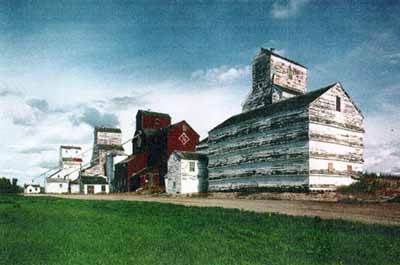Inglis Grain Elevators National Historic Site of Canada
Inglis, Manitoba

General view
© Heritage Recording and Technical Data Services, Heritage Conservation Program, RPS, ''Designated Building Heritage Recording Report: Preliminary Record of 5 Grain Elevators, Inglis, Manitoba'', September/October 1996.
Address :
Inglis, Manitoba
Recognition Statute:
Historic Sites and Monuments Act (R.S.C., 1985, c. H-4)
Designation Date:
1995-11-24
Dates:
-
1922 to 1941
(Construction)
-
1922 to 1995
(Significant)
Event, Person, Organization:
-
N.M. Paterson & Son
(Organization)
-
Northern Elevator Company
(Organization)
-
Matheson-Lindsay
(Organization)
-
Reliance
(Organization)
-
United Grain Growers
(Organization)
-
National Grain Company
(Organization)
-
Manitoba Wheat Pool
(Organization)
Other Name(s):
-
Inglis Grain Elevators
(Designation Name)
Research Report Number:
1995-063, 1997-037
Plaque(s)
Existing plaque: Inglis, Manitoba
This impressive grouping of five standard-plan wooden grain elevators is a rare survivor of the long rows that once dominated Prairie towns. The row was built between 1922 and 1941, Manitoba's golden age of elevators, by a cross-section of grain-handling firms, including cooperatives and large companies backed by Canadian and American investors. Located in a town typical of many that dot the West, these slope-shouldered sentinels are surrounded by their outbuildings, rail line and fields of grain. They stand as powerful symbols of the Prairie landscape and lifestyle.
Description of Historic Place
In the small town of Inglis, Manitoba, a row of tall wooden elevators are lined up parallel to the railway tracks. This is the Inglis Grain Elevators National Historic Site of Canada - a rare surviving icon of prairie towns during the “golden age of grain.” The elevators, no longer in active use, are preserved as a historic site. The designation refers to the elevators, their associated buildings and stretch of railway track.
Heritage Value
Inglis Grain Elevators were designated a national historic site of Canada in 1997 because: they are rare survivors in Western Canada and perhaps the last example of a large row from the “golden age” of elevators remaining in Manitoba; the row is substantially intact, both architecturally and mechanically; the individual elevators, erected between 1922 and 1941, are good illustrations of a number of the important types built by elevator companies operating on the Prairies at the time, including the co-operatives, the larger Canadian- and American-backed companies and smaller companies; the row is set adjacent to elevator-related outbuildings and a rail line which contribute to the strong “elevator landscape”; the rural community in which Inglis is located, is an important grain-growing district and is typical in form and character of the many small communities which once dotted the Canadian Prairies.
The heritage value of Inglis Grain Elevators National Historic Site of Canada lies in its symbolic, visual and substantial representation of a phenomenon typical of the landscape of prairie towns through the early and mid 20th century.
These five grain elevators were built along a Canadian Pacific Railway right-of-way that served the newly created town of Inglis, completed in 1922. Four of these elevators were constructed during the golden age of grain; the fifth was built during the Second World War. They were built by companies familiar to such locations – N.M. Paterson & Son (1922), the Northern Elevator Company (1922), Matheson-Lindsay (1922-23), Reliance (1941), and the United Grain Growers (1925). Ownership of these buildings consolidated and changed over the years, encompassing other familiar companies such as the National Grain Company, the Manitoba Wheat Pool. Since the elevators closed in 1995, they have been restored for tourism purposes.
Sources: Historic Sites and Monuments Board of Canada, Minutes, June 1997; Commemorative Integrity Statement.
Character-Defining Elements
Key elements contributing to the heritage value of the site include:
the completeness of the cultural landscape created by the buildings and the rail line in its small town setting; the profile and alignment of five peak-roofed “standard plan” elevators along the track; the elevators in their found forms, volumes, wooden materials and configurations; the minor distinctions in their designs which reflect different elevator types (such as the round storage bin at Elevator #3); the presence of bin annexes at each building in their found form and materials; evidence of original ownership by different companies on the exterior of the buildings (such as painted signage); the similar configuration of space on the interior of individual elevators (granary, drive shed, dual purpose office/engine shed); the continuity of interior spaces with a high degree of integrity in individual elevators (the offices in Elevators # 1 and 2); the presence and integrity of the functional machinery they contain (particularly the driveway shed, balloon and crib annexes in Elevator #2); the presence of the railway track along which they are situated in a linear row; the forms, materials, functions and construction technology of the low surrounding outbuildings that support their function; viewscapes to and from the elevators to the main street of town and across the flat prairie.